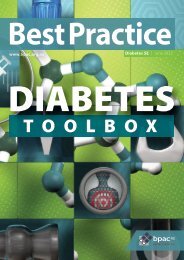You also want an ePaper? Increase the reach of your titles
YUMPU automatically turns print PDFs into web optimized ePapers that Google loves.
Febuxostat and CVD risk. In 2019, the FDA updated their<br />
prescribing information with a boxed warning regarding<br />
an increased risk of all-cause and cardiovascular mortality<br />
with febuxostat. However, the <strong>2020</strong> American College of<br />
Rheumatology gout guidelines now prioritise febuxostat as<br />
the second-line urate lowering treatment over probenecid in<br />
patients without a history of CVD, or if they have significant<br />
renal impairment or urolithiasis. This is based on new data<br />
from a large observational study that did not show an<br />
increased risk of CVD or all-cause mortality with febuxostat. 6<br />
However, given that these recommendations are so recent<br />
they are not yet incorporated into guidance in New Zealand,<br />
and in addition, Special Authority criteria for funded access to<br />
febuxostat still requires that probenecid is trialled first unless<br />
contraindicated.<br />
Benzbromarone should no longer be used<br />
Benzbromarone is a uricosuric medicine that has previously<br />
been prescribed with Special Authority approval to a small<br />
number of patients with gout when other urate-lowering<br />
options were ineffective, not tolerated or contraindicated.<br />
However, as of May <strong>2020</strong>, benzbromarone is out of stock at a<br />
wholesaler level in New Zealand, and PHARMAC has advised<br />
that it will likely delist it from the Pharmaceutical schedule,<br />
although no date is currently set. 14 Therefore, it is now advised<br />
that no newly diagnosed patients should be started on this<br />
medicine, and those currently taking it should change to<br />
another urate-lowering treatment.<br />
Monitoring patients taking urate-lowering<br />
medicines<br />
Once gout is well-controlled with urate-lowering medicines,<br />
reviews should take place regularly every 6–12 months. 8<br />
Patients need to be consistently monitored to: 3<br />
References<br />
1. Winnard D, Wright C, Taylor WJ, et al. National prevalence of gout<br />
derived from administrative health data in Aotearoa New Zealand.<br />
Rheumatology 2012;51:901–9. doi:10.1093/rheumatology/ker361<br />
2. Health Quality & Safety Commission New Zealand. Gout. 2018.<br />
Available from: https://public.tableau.com/profile/hqi2803#!/vizhome/<br />
Goutsinglemap/AtlasofHealthcareVariationGout (Accessed Jul, <strong>2020</strong>)<br />
3. Hui M, Carr A, Cameron S, et al. The British Society for Rheumatology<br />
Guideline for the management of gout. Rheumatology 2017;56:1246.<br />
doi:10.1093/rheumatology/kex250<br />
4. Spencer K, Carr A, Doherty M. Patient and provider barriers to effective<br />
management of gout in general practice: a qualitative study. Ann<br />
Rheum Dis 2012;71:1490–5. doi:10.1136/annrheumdis-2011-200801<br />
5. MacFarlane LA, Kim SC. Gout: a review of non-modifiable and<br />
modifiable risk factors. Rheumatic Disease Clinics of North America<br />
2014;40:581–604. doi:10.1016/j.rdc.2014.07.002<br />
6. FitzGerald JD, Dalbeth N, Mikuls T, et al. <strong>2020</strong> American College of<br />
Rheumatology Guideline for the management of gout. Arthritis Care Res<br />
<strong>2020</strong>;72:744–60. doi:10.1002/acr.24180<br />
7. Janssens HJEM, Fransen J, van de Lisdonk EH, et al. A diagnostic rule for<br />
acute gouty arthritis in primary care without joint fluid analysis. Arch<br />
Intern Med 2010;170:1120–6. doi:10.1001/archinternmed.2010.196<br />
8. Dalbeth N, Winnard D, Gow PJ, et al. Urate testing in gout: why, when<br />
and how. N Z Med J 2015;128:65–8.<br />
9. Richette P, Doherty M, Pascual E, et al. 2016 updated EULAR evidencebased<br />
recommendations for the management of gout. Ann Rheum Dis<br />
2017;76:29–42. doi:10.1136/annrheumdis-2016-209707<br />
10. New Zealand Formulary (NZF). NZF v97. Available from: www.nzf.org.nz<br />
(Accessed Jul, <strong>2020</strong>).<br />
11. Su X, Xu B, Yan B, et al. Effects of uric acid-lowering therapy in<br />
patients with chronic kidney disease: A meta-analysis. PLoS ONE<br />
2017;12:e0187550. doi:10.1371/journal.pone.0187550<br />
12. Perez-Ruiz F, Herrero-Beites AM, Carmona L. A two-stage approach to the<br />
treatment of hyperuricemia in gout: the ‘dirty dish’ hypothesis. Arthritis<br />
Rheum 2011;63:4002–6. doi:10.1002/art.30649<br />
13. Stamp LK, Taylor WJ, Jones PB, et al. Starting dose is a risk factor for<br />
allopurinol hypersensitivity syndrome: a proposed safe starting dose of<br />
allopurinol. Arthritis Rheum 2012;64:2529–36. doi:10.1002/art.34488<br />
14. PHARMAC. Benzbromarone: Discontinuation. Available from: https://<br />
www.pharmac.govt.nz/information-for/enquiries/benzbromaronesupply-issue/<br />
(Accessed Jul, <strong>2020</strong>)<br />
Ensure serum urate levels are achieved and remain below<br />
saturation point<br />
Ensure their renal function has not deteriorated<br />
Encourage ongoing treatment adherence and lifestyle<br />
changes<br />
Manage CVD risk factors, e.g. HbA 1C,<br />
blood pressure<br />
Treat any co-morbidities that may emerge<br />
For the original and extended version of this article<br />
(published as a two-part series) see: “Part 1 – Talking about<br />
gout: time for a re-think” (available at https://bpac.org.<br />
nz/2018/gout-part1.aspx) and “Controlling gout with longterm<br />
urate-lowering medicines” (available at https://bpac.org.<br />
nz/2018/gout-part2.aspx)<br />
www.bpac.org.nz<br />
Best Practice Journal – SCE Issue 1 31









